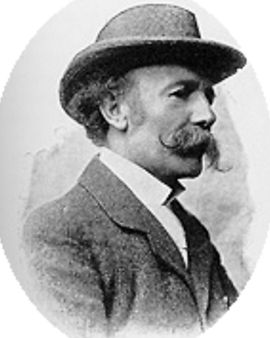Frederick Morgan, born in 1847 and died on April 3, 1927, was a British painter of a special caliber who specialized in portraits, animals, and rural and domestic scenes. His works reflected the idyllic moments of childhood and made him a significant figure in the world of art. The ability to capture the innocence and joy of childhood made his works stand out in the art scene and captivated a wide audience. Born in London to John Morgan, a successful genre painter, and Henrietta Hester Clare, Morgan began his artistic journey early. He was introduced to the world of art by his father at the age of fourteen and his talent soon became apparent. By the age of sixteen, his first painting, "The Rehearsal," was exhibited at the Royal Academy. He worked for a time as a portrait artist for a photographer in Aylesbury, an experience that sharpened his eye for detail and enhanced his talent for close observation.
In time, Morgan found his true expression in depicting rural and domestic scenes and, in particular, childhood in its most idyllic moments. Beginning in 1874, his works were purchased by Thomas Agnew & Sons and he produced some of his most famous works such as "The Doll's Tea Party" (1874), "Emigrants' Departure" (1875), and "School Belles" (1877). Many of these masterpieces were created in the village of Shere near Guildford, a popular retreat for artists. Although he was considered an excellent portrait artist, Morgan was open to assistance when it came to depicting pets and farm animals. For this, he enlisted the help of artists such as Arthur John Elsley and Allen Sealey. Morgan found his greatest appreciation in the romantic and sentimental depictions of children, similar to his contemporary Arthur John Elsley. These paintings gained great popularity during his lifetime and were widely published.
As a member of the Royal Institute of Oil Painters (ROI), Morgan's work gained wide attention in the art world. In 1872 he married painter Alice Mary Havers, with whom he had three children, one of whom, Val Havers, also became a painter. Frederick Morgan married twice more and had two more children from the second marriage. Today, you can admire Morgan's work in numerous art galleries and museums, including the Walker Art Gallery in Liverpool and the Russell-Cotes Museum in Bournemouth. Our company honors the legacy of this remarkable artist by producing and selling excellent fine art prints of his work. In each reproduction, we strive to maintain the detail and charm that distinguish Morgan's originals, bringing the spirit of his art to life.
×





.jpg)
.jpg)
.jpg)
.jpg)
.jpg)
.jpg)
.jpg)
.jpg)
.jpg)
.jpg)
.jpg)
.jpg)
.jpg)
.jpg)
.jpg)
.jpg)
.jpg)
.jpg)
.jpg)
.jpg)
.jpg)
.jpg)
.jpg)
.jpg)
.jpg)
.jpg)
 - (MeisterDrucke-240718).jpg)
 - (MeisterDrucke-240718).jpg)
.jpg)
.jpg)
.jpg)
.jpg)
.jpg)
.jpg)
.jpg)
.jpg)
.jpg)
.jpg)
.jpg)
.jpg)
.jpg)
.jpg)
_-_(MeisterDrucke-1172233).jpg)
_-_(MeisterDrucke-1172233).jpg)
.jpg)
.jpg)
.jpg)
.jpg)
.jpg)
.jpg)
.jpg)
.jpg)
.jpg)
.jpg)
.jpg)
.jpg)
.jpg)
.jpg)
.jpg)
.jpg)
.jpg)
.jpg)
.jpg)
.jpg)
.jpg)
.jpg)
.jpg)
.jpg)
.jpg)
.jpg)
.jpg)
.jpg)
.jpg)
.jpg)
.jpg)
.jpg)
.jpg)
.jpg)
.jpg)
.jpg)
.jpg)
.jpg)
.jpg)
.jpg)
.jpg)
.jpg)
.jpg)
.jpg)
.jpg)
.jpg)
.jpg)
.jpg)
.jpg)
.jpg)
.jpg)
.jpg)
.jpg)
.jpg)
.jpg)
.jpg)
.jpg)
.jpg)
.jpg)
.jpg)
.jpg)
.jpg)
.jpg)
.jpg)
.jpg)
.jpg)
.jpg)
.jpg)




